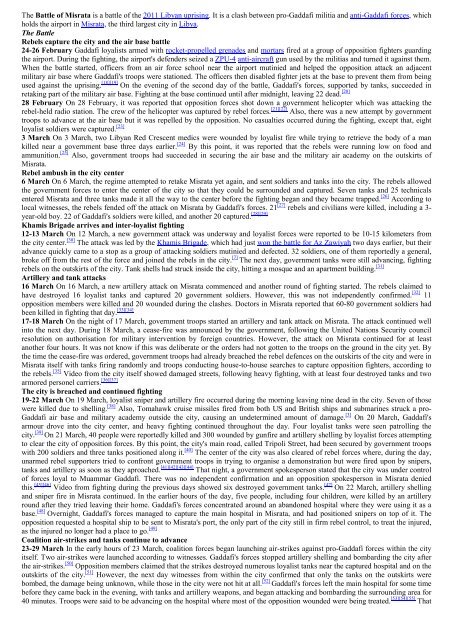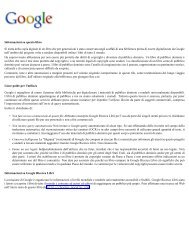Libyan Civil War Libyan Civil War - Libreria Militare Ares
Libyan Civil War Libyan Civil War - Libreria Militare Ares
Libyan Civil War Libyan Civil War - Libreria Militare Ares
You also want an ePaper? Increase the reach of your titles
YUMPU automatically turns print PDFs into web optimized ePapers that Google loves.
The Battle of Misrata is a battle of the 2011 <strong>Libyan</strong> uprising. It is a clash between pro-Gaddafi militia and anti-Gaddafi forces, which<br />
holds the airport in Misrata, the third largest city in Libya.<br />
The Battle<br />
Rebels capture the city and the air base battle<br />
24-26 February Gaddafi loyalists armed with rocket-propelled grenades and mortars fired at a group of opposition fighters guarding<br />
the airport. During the fighting, the airport's defenders seized a ZPU-4 anti-aircraft gun used by the militias and turned it against them.<br />
When the battle started, officers from an air force school near the airport mutinied and helped the opposition attack an adjacent<br />
military air base where Gaddafi's troops were stationed. The officers then disabled fighter jets at the base to prevent them from being<br />
used against the uprising. [18][19] On the evening of the second day of the battle, Gaddafi's forces, supported by tanks, succeeded in<br />
retaking part of the military air base. Fighting at the base continued until after midnight, leaving 22 dead. [20]<br />
28 February On 28 February, it was reported that opposition forces shot down a government helicopter which was attacking the<br />
rebel-held radio station. The crew of the helicopter was captured by rebel forces. [21][22] Also, there was a new attempt by government<br />
troops to advance at the air base but it was repelled by the opposition. No casualties occurred during the fighting, except that, eight<br />
loyalist soldiers were captured. [23]<br />
3 March On 3 March, two <strong>Libyan</strong> Red Crescent medics were wounded by loyalist fire while trying to retrieve the body of a man<br />
killed near a government base three days earlier. [24] By this point, it was reported that the rebels were running low on food and<br />
ammunition. [25] Also, government troops had succeeded in securing the air base and the military air academy on the outskirts of<br />
Misrata.<br />
Rebel ambush in the city center<br />
6 March On 6 March, the regime attempted to retake Misrata yet again, and sent soldiers and tanks into the city. The rebels allowed<br />
the government forces to enter the center of the city so that they could be surrounded and captured. Seven tanks and 25 technicals<br />
entered Misrata and three tanks made it all the way to the center before the fighting began and they became trapped. [26] According to<br />
local witnesses, the rebels fended off the attack on Misrata by Gaddafi's forces. 21 [27] rebels and civilians were killed, including a 3-<br />
year-old boy. 22 of Gaddafi's soldiers were killed, and another 20 captured. [28][29]<br />
Khamis Brigade arrives and inter-loyalist fighting<br />
12-13 March On 12 March, a new government attack was underway and loyalist forces were reported to be 10-15 kilometers from<br />
the city center. [30] The attack was led by the Khamis Brigade, which had just won the battle for Az Zawiyah two days earlier, but their<br />
advance quickly came to a stop as a group of attacking soldiers mutinied and defected. 32 soldiers, one of them reportedly a general,<br />
broke off from the rest of the force and joined the rebels in the city. [7] The next day, government tanks were still advancing, fighting<br />
rebels on the outskirts of the city. Tank shells had struck inside the city, hitting a mosque and an apartment building. [31]<br />
Artillery and tank attacks<br />
16 March On 16 March, a new artillery attack on Misrata commenced and another round of fighting started. The rebels claimed to<br />
have destroyed 16 loyalist tanks and captured 20 government soldiers. However, this was not independently confirmed. [32] 11<br />
opposition members were killed and 20 wounded during the clashes. Doctors in Misrata reported that 60-80 government soldiers had<br />
been killed in fighting that day. [33][34]<br />
17-18 March On the night of 17 March, government troops started an artillery and tank attack on Misrata. The attack continued well<br />
into the next day. During 18 March, a cease-fire was announced by the government, following the United Nations Security council<br />
resolution on authorisation for military intervention by foreign countries. However, the attack on Misrata continued for at least<br />
another four hours. It was not know if this was deliberate or the orders had not gotten to the troops on the ground in the city yet. By<br />
the time the cease-fire was ordered, government troops had already breached the rebel defences on the outskirts of the city and were in<br />
Misrata itself with tanks firing randomly and troops conducting house-to-house searches to capture opposition fighters, according to<br />
the rebels. [35] Video from the city itself showed damaged streets, following heavy fighting, with at least four destroyed tanks and two<br />
armored personel carriers. [36][37]<br />
The city is breached and continued fighting<br />
19-22 March On 19 March, loyalist sniper and artillery fire occurred during the morning leaving nine dead in the city. Seven of those<br />
were killed due to shelling. [38] Also, Tomahawk cruise missiles fired from both US and British ships and submarines struck a pro-<br />
Gaddafi air base and military academy outside the city, causing an undetermined amount of damage. [3] On 20 March, Gaddafi's<br />
armour drove into the city center, and heavy fighting continued throughout the day. Four loyalist tanks were seen patrolling the<br />
city. [39] On 21 March, 40 people were reportedly killed and 300 wounded by gunfire and artillery shelling by loyalist forces attempting<br />
to clear the city of opposition forces. By this point, the city's main road, called Tripoli Street, had been secured by government troops<br />
with 200 soldiers and three tanks positioned along it. [40] The center of the city was also cleared of rebel forces where, during the day,<br />
unarmed rebel supporters tried to confront government troops in trying to organise a demonstration but were fired upon by snipers,<br />
tanks and artillery as soon as they aproached. [41][42][43][44] That night, a government spokesperson stated that the city was under control<br />
of forces loyal to Muammar Gaddafi. There was no independent confirmation and an opposition spokesperson in Misrata denied<br />
this. [45][46] Video from fighting during the previous days showed six destroyed government tanks. [47] On 22 March, artillery shelling<br />
and sniper fire in Misrata continued. In the earlier hours of the day, five people, including four children, were killed by an artillery<br />
round after they tried leaving their home. Gaddafi's forces concentrated around an abandoned hospital where they were using it as a<br />
base. [48] Overnight, Gaddafi's forces managed to capture the main hospital in Misrata, and had positioned snipers on top of it. The<br />
opposition requested a hospital ship to be sent to Misrata's port, the only part of the city still in firm rebel control, to treat the injured,<br />
as the injured no longer had a place to go. [49]<br />
Coalition air-strikes and tanks continue to advance<br />
23-29 March In the early hours of 23 March, coalition forces began launching air-strikes against pro-Gaddafi forces within the city<br />
itself. Two air-strikes were launched according to witnesses. Gaddafi's forces stopped artillery shelling and bombarding the city after<br />
the air-strikes. [50] Opposition members claimed that the strikes destroyed numerous loyalist tanks near the captured hospital and on the<br />
outskirts of the city. [51] However, the next day witnesses from within the city confirmed that only the tanks on the outskirts were<br />
bombed, the damage being unknown, while those in the city were not hit at all. [52] Gaddafi's forces left the main hospital for some time<br />
before they came back in the evening, with tanks and artillery weapons, and began attacking and bombarding the surrounding area for<br />
40 minutes. Troops were said to be advancing on the hospital where most of the opposition wounded were being treated. [53][54][55] That
















